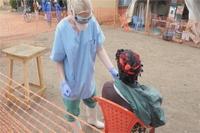-
Funding cuts hamper health agencies’ ability to prepare for, respond to Ebola
Federal and state funds for local health agencies have been cut over the past few years, so when hospitals and municipal health agencies are asked proactively to respond to possible threats of Ebola, many question how they will fund such activities. Since 2008, at least 51,000 state and local public health jobs (roughly 20 percent) have been lost due to cuts in federal funding.
-
-
Epidemics do not require long-distance travel by virus carriers to spread
The current Ebola outbreak shows how quickly diseases can spread with global jet travel. Yet knowing how to predict the spread of these epidemics is still uncertain, because the complicated models used are not fully understood. Using a very simple model of disease spread, UC Berkeley biophysicist Oskar Hallatschek proved that one common assumption is actually wrong. Most models have taken for granted that if disease vectors, such as humans, have any chance of “jumping” outside the initial outbreak area — by plane or train, for example – the outbreak quickly metastasizes into an epidemic. Hallatschek and colleagues found instead that if the chance of long-distance dispersal is low enough, the disease spreads quite slowly, like a wave rippling out from the initial outbreak. This type of spread was common centuries ago when humans rarely traveled. The Black Death spread through fourteenth-century Europe as a wave, for example.
-
-
U.S. will see between 1 and 130 additional Ebola cases by end of 2014: Experts

Top U.S. medical experts studying the spread of Ebola predict a few more cases will reach America before year’s end, citing the return of healthcare workers currently working in West Africa as the most likely cause of new cases. Using data models that weigh several variables including daily new infections in West Africa, global airline traffic, and transmission possibilities, top infectious disease experts predict as few as one or two additional infections and as many as 130 by the end of 2014.
-
-
Rate of infection in West Africa has begun to slow down

Public health officials monitoring the Ebola epidemic in West Africa say the outbreak may have reached a turning point in which transmissions may have begun to slow down. Dr. Jeremy Farrar, director of the Wellcome Trust, the organization funding a series of fast-tracked trials of Ebola vaccines and drugs, says that although the virus will continue to infect people in the months ahead, “it is finally becoming possible to see some light.”
-
-
Infection outbreaks, unique diseases on the increase since 1980
Ebola has a lot of company. In a novel database now made publicly available, researchers found that since 1980 the world has seen an increasing number of infectious disease outbreaks from an increasing number of sources. The good news, however, is that they are affecting a shrinking proportion of the world population. The number of infectious disease outbreaks and the number of unique illnesses causing them appear to be increasing around the globe, with more than 12,000 outbreaks affecting forty-four million people worldwide over the last thirty-three years.
-
-
Lack of federal authority makes fashioning coherent national Ebola policy difficult

Earlier this week, the Centers for Disease Control and Prevention(CDC) issued new guidelines on how states should deal with travelers from Ebola-stricken regions, but a lack of federal authority to mandate such guidelines has led to conflicting strategies, varying from state to state, which includes mandatory at-home quarantine for some travelers. Under current U.S. law, the states have the authority to issue quarantine or isolation policies, and they also control the enforcement of these policies within their territories.
-
-
Legality of mandatory quarantine of asymptomatic individuals questioned
Roughly three decades ago, patients in New York were forced into isolationafter an outbreak of tuberculosis, and about seventy years before that, an influenza pandemic led to mass quarantine in major American cities. Today, fear of an Ebola outbreak in the United States has led some states to mandate quarantine of individuals suspected of having the Ebola virus, but legal analysts question the legality of such measures.
-
-
Experts consider implications of Ebola strain being stolen from lab
As the Ebola virus continues to plague several Americans and Europeans and thousands in Africa, researchers are beginning to examine the outcomes should a strain of Ebola be stolen from a testing laboratory. Many scientists in U.S. labs study the Ebola virus in order to find out how they can fight it. They wonder, however, what set of procedures are in place if a sample of the virus was stolen.
-
-
Insurance companies now write Ebola exclusions into policies; offer Ebola-related products
U.S. and British insurance companies have begun to write Ebola exclusions into their policies for hospitals, event organizers, airliners, and other businesses vulnerable to disruption from the disease. As a result, new policies and renewals will become more expensive for firms looking to insure business travel to West Africa or to cover the risk of losses from Ebola-driven business interruptions (BI).The cost of insuring an event against Ebola, for example, would likely be triple the amount of normal cancellation insurance — if the venue was in a region not known to be affected by the virus.
-
-
Private cleaning firms had to improvise when cleaning apartments of U.S. Ebola patients

Officials responsible for disinfecting the Ebola-infected homes of Thomas Eric Duncan’s fiancee, and of the two nurses he infected, relied on best decontamination practices, but note that an official manual for responding to a home contaminated with the Ebola virus was nonexistent at the time. OSHA recently announced official guidelines for “Cleaning and Decontamination of Ebola on Surfaces” for workers and employers in non-healthcare/non-laboratory settings.
-
-
First New York Ebola case confirmed
Dr. Craig Spencer, who had been working with Doctors without Borders in Guinea and treating Ebola patients before returning to New York City on 14 October, was taken to Bellevue Hospital yesterday (Thursday) and placed in strict isolation. Tests later determined that he had contracted the Ebola virus. Spencer is the first New Yorker diagnosed with Ebola. As if in anticipation of a case like Dr. Spencer’s, more than 5,000 healthcare workers in New York participated in a three-hour session earlier this week to prepare for Ebola should an infected person arrive in the New York City region.
-
-
RMS develops probabilistic model of West African Ebola outbreak
Current outbreak has the potential to be the deadliest infectious disease event since the 1918 flu pandemic. The outbreak will worsen and could reach as many as 1,400 new cases per day within a month, according to pandemic risk experts. According to a new model developed by RMS, until a tipping point is reached at which the number of new daily cases declines rather than increases, the severity of the outbreak will continue to multiply, with the total number of new cases approximately doubling each month.
-
-
Ebola kills, but it may be immunizing others at the same time
As Ebola continues to spread in West Africa, it may be silently immunizing large numbers of people who never fall ill or infect others, yet become protected from future infection. If such immunity is confirmed, it would have significant ramifications on projections of how widespread the disease will be and could help determine strategies that health workers use to contain the disease.
-
-
Connecticut issues new Ebola guidelines
Officials in Connecticut have issued new guidelines which require individuals returning from West Africa with no symptoms of Ebola to be quarantined for twenty-one days. Although the guidelines require travelers with no symptoms of Ebola to be quarantined at home, state Health Commissioner Dr. Jewel Mullen recently said that her office would review each quarantine-eligible case before enforcing the measure.
-
-
U.S. officials mull quarantines, other options should Ebola spread
With the possibility of a wider spread of Ebola in the United States, U.S. officials are weighing the legal authority of instituting quarantines, while also keeping public panic to a minimum. while medical expertise and updated guidelines have been provided by the CDC, federal government officials are also considering the implications of quarantines, bans on travel to-and-from other countries, and public health emergency declarations which could tap into more earmarked funds for larger operations.
-
- All
- Regional
- Water
- Biometrics
- Borders/Immig
- Business
- Cybersecurity
- Detection
- Disasters
- Government
- Infrastructure
- International
- Public health
- Public Safety
- Communication interoperabillity
- Emergency services
- Emergency medical services
- Fire
- First response
- IEDs
- Law Enforcement
- Law Enforcement Technology
- Military technology
- Nonlethal weapons
- Nuclear weapons
- Personal protection equipment
- Police
- Notification /alert systems
- Situational awareness
- Weapons systems
- Sci-Tech
- Sector Reports
- Surveillance
- Transportation
Advertising & Marketing: advertise@newswirepubs.com
Editorial: editor@newswirepubs.com
General: info@newswirepubs.com
2010-2011 © News Wire Publications, LLC News Wire Publications, LLC
220 Old Country Road | Suite 200 | Mineola | New York | 11501
Permissions and Policies
Editorial: editor@newswirepubs.com
General: info@newswirepubs.com
2010-2011 © News Wire Publications, LLC News Wire Publications, LLC
220 Old Country Road | Suite 200 | Mineola | New York | 11501
Permissions and Policies
